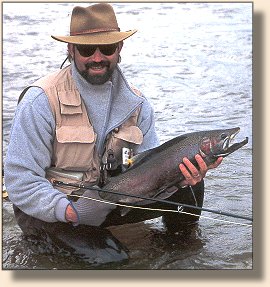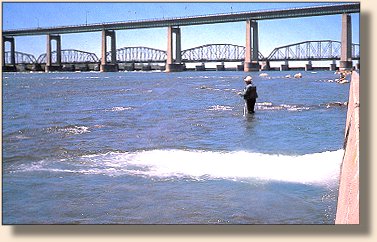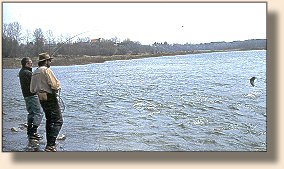Steelhead
Lake Huron and Georgian Bay Streams
By Scott E. Smith
 Lake Huron was the first of the Great Lakes to be stocked with
rainbow trout; primarily stock from the McCloud River system in
California. According to "Rainbow Trout In the Great Lakes," a paper
by Hugh R. MacCrimmon and Barra Lowe Gots for the Ontario Ministry
of Natural Resources (1972), the first watershed in the Great Lakes
to receive rainbow trout was Michigan's Au Sable River in 1876.
In 1896 rainbows were introduced in several other Michigan (Lake
Huron) tributaries, and the first capture of rainbow trout in
Ontario took place in the Nottawasago River. Coincidental or not,
it seems significant that both the AuSable and the Nottawasaga
presently support strong populations of self-sustaining rainbow
trout, which we have come to know and love as steelhead.
Lake Huron was the first of the Great Lakes to be stocked with
rainbow trout; primarily stock from the McCloud River system in
California. According to "Rainbow Trout In the Great Lakes," a paper
by Hugh R. MacCrimmon and Barra Lowe Gots for the Ontario Ministry
of Natural Resources (1972), the first watershed in the Great Lakes
to receive rainbow trout was Michigan's Au Sable River in 1876.
In 1896 rainbows were introduced in several other Michigan (Lake
Huron) tributaries, and the first capture of rainbow trout in
Ontario took place in the Nottawasago River. Coincidental or not,
it seems significant that both the AuSable and the Nottawasaga
presently support strong populations of self-sustaining rainbow
trout, which we have come to know and love as steelhead.
During the first three decades of the twentieth century, stocking
of rainbow trout in Lake Huron continued in various locations
within the province. Combined with the natural movement of the
species, these stockings established what we now enjoy as prolific
wild runs of steelhead in most of Lake Huron's Ontario tributaries.
Steelhead that average between six and eight pounds - with numerous
fish over ten pounds and the odd fish approaching the twenty-pound
mark - are available to the fly angler during both spring and fall
runs in many important spawning tributaries. At present the bulk of
the Lake Huron steelhead that run Ontario streams are wild, particularly
in Georgian Bay tributaries; however some stocking by the OMNR and
local fishing clubs occurs in Lake Huron streams, such as the Saugeen,
Maitland, Bayfield and Nine Mile rivers. Summer-run steelhead in
Huron tributaries are uncommon, with only a marginal number of
stray Skamanie-strain (from previous planting by the State of
Michigan and by private clubs in Ontario) entering some streams
in the last week of July and the first week of August.

Additionally, runs of Pacific salmon, (Chinook, pink and coho),
brown trout, lake trout, whitefish, and in some cases, Atlantic
salmon, provide a variety of spirited salmonids for pursuit by
the fly anglers. With the exception of the indigenous lake trout
and lake whitefish, these species were also successfully introduced
since the turn of the last century. Chinook salmon, which are
still extensively stocked by local clubs primarily for the benefit
of open-lake boat anglers, average around fifteen pounds and are
present in almost all important tributaries mentioned [here].
Coho salmon, which are no longer stocked, have a small self-sustaining
stronghold in streams such as the Nottawasaga, Sauble, Maitland
and Nine Mile rivers. Pink salmon are present in many tributaries,
but not terribly common or popular, except in the St. Mary's,
which receives a large and regular run during odd years and decent
runs in even years. (Other rivers receive marginal runs in odd
years and almost no pinks in even years.)
 To add to this cornucopia of fish, many of Huron's more fertile
cold-water tributaries, such as the Saugeen, the Beaver and the
Nottawasaga, support resident populations of brook trout, rainbow
trout and brown trout - offering almost year-round opportunities
for trout and salmon buffs. Smallmouth bass, northern pike, perch
and walleye (and a number of lesser-known warmwater species) are
also eager to smash a fly in many of the warmer tributaries, such
as the Maitland and the Bayfield rivers, which also support runs
of salmonids during the spring and fall.
To add to this cornucopia of fish, many of Huron's more fertile
cold-water tributaries, such as the Saugeen, the Beaver and the
Nottawasaga, support resident populations of brook trout, rainbow
trout and brown trout - offering almost year-round opportunities
for trout and salmon buffs. Smallmouth bass, northern pike, perch
and walleye (and a number of lesser-known warmwater species) are
also eager to smash a fly in many of the warmer tributaries, such
as the Maitland and the Bayfield rivers, which also support runs
of salmonids during the spring and fall.
Consistent with other regions in the Great Lakes Basin, the
steelhead attracts the most attention from fly anglers on Ontario's
Huron streams. Lake Huron steelhead are regarded as large
streamlined fish that fight hard and fast, and take flies well.
In contrast to Superior's steelhead, which seem to have a
predisposition for egg/attractor patterns, Huron steelhead are
duped regularly with more traditional nymph imitations that
represent important insects in each particular river. The
reason for this penchant for nymphs comes from the predominant
limestone, agriculturally based soils through which many of
Huron's tributaries flow. These water conditions make for rich
habitat for invertebrates, which in turn provide a forage base
for juvenile steelhead and resident trout. According to Larry
Halyk, Ontario Ministry of Natrual Resources biologist and
fly-fishing guru, all of the major mayfly, caddis and stonefly
taxa are well represented in the important Huron tributaries.
Even died-in-the-wool roe fishermen opt for small black stonefly
imitations fished under their floats in early spring.
~ Scott E. Smith
Credits: From Ontario Blue-Ribbon Fly Fishing Guide
by Scott E. Smith. We thank
Frank Amato Publications, Inc. for use permission!
Our Man In Canada Archives
|

